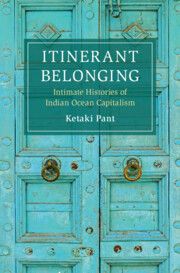Refine search
Actions for selected content:
163 results
Archives
-
- Book:
- The Archives and Afterlives of Nautch Dancers in India
- Published online:
- 24 October 2025
- Print publication:
- 13 November 2025, pp 1-24
-
- Chapter
- Export citation
1 - Nautch in Colonial Human Exhibits, and the (Im)Possibility of Dance Reenactments
-
- Book:
- The Archives and Afterlives of Nautch Dancers in India
- Published online:
- 24 October 2025
- Print publication:
- 13 November 2025, pp 25-54
-
- Chapter
- Export citation
4 - Joyous Courtesan Worlds
-
- Book:
- The Archives and Afterlives of Nautch Dancers in India
- Published online:
- 24 October 2025
- Print publication:
- 13 November 2025, pp 134-169
-
- Chapter
- Export citation
Afterlives of Nautch
-
- Book:
- The Archives and Afterlives of Nautch Dancers in India
- Published online:
- 24 October 2025
- Print publication:
- 13 November 2025, pp 170-180
-
- Chapter
- Export citation
2 - Insurgent Gestures
-
- Book:
- The Archives and Afterlives of Nautch Dancers in India
- Published online:
- 24 October 2025
- Print publication:
- 13 November 2025, pp 55-87
-
- Chapter
- Export citation
3 - Sundaris and Jans in the Age of Mechanical Reprodarshan
-
- Book:
- The Archives and Afterlives of Nautch Dancers in India
- Published online:
- 24 October 2025
- Print publication:
- 13 November 2025, pp 88-133
-
- Chapter
- Export citation

The Archives and Afterlives of Nautch Dancers in India
-
- Published online:
- 24 October 2025
- Print publication:
- 13 November 2025
Chapter 8 - Bloomsbury, South Asia, and Empire
- from Part II - Global Bloomsbury
-
-
- Book:
- A History of the Bloomsbury Group
- Published online:
- 09 October 2025
- Print publication:
- 23 October 2025, pp 121-137
-
- Chapter
- Export citation
Psychiatric education in South Asia
-
- Journal:
- BJPsych Advances , FirstView
- Published online by Cambridge University Press:
- 12 September 2025, pp. 1-3
-
- Article
- Export citation
To Reinforce or Replace: Courts and Democratic Backsliding
-
- Journal:
- Government and Opposition , First View
- Published online by Cambridge University Press:
- 22 August 2025, pp. 1-26
-
- Article
-
- You have access
- Open access
- HTML
- Export citation
‘Beastial Communications’: Race, Friendship and Factionalism in the Madras Army, 1832–1837
-
- Journal:
- Transactions of the Royal Historical Society , First View
- Published online by Cambridge University Press:
- 06 August 2025, pp. 1-26
-
- Article
-
- You have access
- Open access
- HTML
- Export citation
Rethinking Marriage: Blurring the “Legal” and the “Social”
-
- Journal:
- Law & Social Inquiry , First View
- Published online by Cambridge University Press:
- 04 August 2025, pp. 1-38
-
- Article
-
- You have access
- Open access
- HTML
- Export citation
Noah’s grandsons and the elephant: functions of Persian pseudonymous writing in South Asia
-
- Journal:
- Journal of the Royal Asiatic Society , First View
- Published online by Cambridge University Press:
- 25 July 2025, pp. 1-26
-
- Article
- Export citation
Chapter 26 - Realism and the South Asian Novel
- from Part IV - Locations of Realism
-
-
- Book:
- Realism and the Novel
- Published online:
- 05 June 2025
- Print publication:
- 19 June 2025, pp 372-388
-
- Chapter
- Export citation
Through the Prism of Community Development: Decolonization and the Cold War Politics of Agrarian Modernization in East Pakistan
-
- Journal:
- Social Science History , First View
- Published online by Cambridge University Press:
- 16 May 2025, pp. 1-25
-
- Article
- Export citation

Itinerant Belonging
- Intimate Histories of Indian Ocean Capitalism
-
- Published online:
- 10 April 2025
- Print publication:
- 17 April 2025
Stunting and inequality in Sri Lanka compared with other low- and middle-income South Asian countries
-
- Journal:
- Public Health Nutrition / Volume 28 / Issue 1 / 2025
- Published online by Cambridge University Press:
- 19 March 2025, e63
-
- Article
-
- You have access
- Open access
- HTML
- Export citation
Introduction
-
- Book:
- Mobile Manuscripts
- Published online:
- 30 January 2025
- Print publication:
- 06 February 2025, pp 1-38
-
- Chapter
- Export citation
Conclusion
-
- Book:
- Mobile Manuscripts
- Published online:
- 30 January 2025
- Print publication:
- 06 February 2025, pp 260-266
-
- Chapter
- Export citation
11 - A Fractured Dream of the Decolonisation and De-eliticisation of English within EMI Programmes in South Asia
- from Part III - The Politics of English in Education
-
-
- Book:
- Critical English Medium Instruction in Higher Education
- Published online:
- 31 January 2025
- Print publication:
- 06 February 2025, pp 183-199
-
- Chapter
- Export citation
